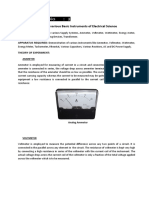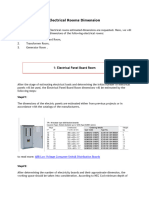Basic Measurements: Experiment 1
Basic Measurements: Experiment 1
Uploaded by
arunkumar_gtsCopyright:
Available Formats
Basic Measurements: Experiment 1
Basic Measurements: Experiment 1
Uploaded by
arunkumar_gtsOriginal Description:
Original Title
Copyright
Available Formats
Share this document
Did you find this document useful?
Is this content inappropriate?
Copyright:
Available Formats
Basic Measurements: Experiment 1
Basic Measurements: Experiment 1
Uploaded by
arunkumar_gtsCopyright:
Available Formats
Experiment 1
Basic Measurements
Objectives
To introduce basic lab equipments such as the multimeter and power supplies
To learn how to measure electrical quantities such as voltage, current, and power using lab
instruments
Introduction
Digital Multimeter
Digital multimeter (DMM) is used to measure electrical quantities such as voltage, current, resistance,
and power as well as to show these quantities digitally. The DMM is easy to use and necessary for all
electrical and electronics laboratories.
Voltage Measurement (The Voltmeter)
To measure a dc voltage in electrical circuits, do the following steps:
1. Turn on the DMM
2. Using the rotary selector switch, select the voltage function "VDC".
3. Select the "AUTO" range mode by making a long press on the" Range" button.
4. Insert the positive (+) lead (normally red) in the voltage socket and the negative (-) lead (normally
black) in the common socket.
5. Place the red probe on the higher voltage point and the black probe on the lower voltage point.
6. Finally, the DMM will display the voltage drop between the probe tips digitally.
Voltage measurement is made by connecting the voltmeter in parallel with the electrical / electronic
component(s) as shown in Figure 1.1. If the probes are reversed the reading will be the same as the
original but negative when compared with the original one. The voltmeter has a very large internal
resistance, which is considered as an open circuit during calculations.
Figure 1.1: A circuit showing how to use two multimeters to measure the voltage and current
0405344: Electrical Machines for Mechatronics Laboratory
11
Experiment 1: Basic Measurements
Current measurement (The Ammeter)
To measure a dc current in some electrical circuits, do the following steps:
1. Turn on the DMM
2. Using the rotary selector switch select the current function "ADC".
3. Place the positive (+) probe in the current socket and the negative (-) one in the common socket.
4. Select the "AUTO" range mode and connect the tips of the probes in series with the circuit
component to measure its current. A positive reading indicates that the current direction is from the
positive (+) to the negative (-) probes.
Current measurement is made by connecting the ammeter in series with a circuit component as shown in
Figure 1.1. The ammeter has very small internal resistance and considered as a short circuit element in
calculations.
CAUTION: Always disconnect the probes of the meter from the circuit before changing the selector
switch from current to voltage or vise versa. Failing to do so may damage the meter. Switching off the
meter without disconnecting the probes is insufficient for protecting the meter. Connecting the
multimeter in an incorrect way, or choosing the wrong selection of switches, may result in personal
injury, damage to the multimeter and/or the lab equipment. Follow safety instructions at all times.
Resistance Measurement (The Ohmmeter)
The ohmmeter, that is part of a multimeter, is basically both a voltmeter and ammeter. A built-in voltage
source is connected across the resistor to supply the measurement circuit with current. The resistance
value is the ratio of voltage drop to current flow. Resistance should never be measured while it is
connected in a circuit. To measure the resistance of a component, do the following steps:
1. Switch off the power from the circuit.
2. Disconnect the component from the circuit.
3. Switch the multimeter to measure resistance, and select the "AUTO" range mode.
4. Connect the probe tips to the component terminals, and read the value displayed.
Power Measurement (The Wattmeter)
Electric power may be measured by means of a wattmeter. This instrument is of the electrodynamic
type. It consists of a pair of fixed coils, known as a current coil, and a movable coil known as the
potential coil, (refer to Figure 1.2). The fixed coils are made up of few turns of a comparatively large
conductance. The potential coil consists of many turns of fine wires. It is mounted on a shaft, carried in
jeweled bearings, so that it may turn inside the stationary coils. The movable coil carries a needle which
moves over a suitably marked scale. Spiral coil springs hold the needle to a zero position.
The current (stationary) coil of the wattmeter is connected in series with the circuit (load), and the
potential (movable) coil is connected across the line. When line current flows through the current coil of
a wattmeter, a field is set up around the coil. The strength of this field is proportional to the line current
and in phase with it. The potential coil of the wattmeter generally has a high resistance. This is for the
purpose of making the potential coil circuit of the meter as purely resistive as possible. As a result,
current in the potential circuit is practically in phase with line voltage. Therefore, when voltage is
applied to the potential circuit, current is proportional to and in phase with the line voltage. The
actuating force of a wattmeter comes from the magnetic fields of its current and potential coils. The
force acting on the movable coil at any instant (tending to turn it) is proportional to the instantaneous
values of line current and voltage.
0405344: Electrical Machines for Mechatronics Laboratory
12
Experiment 1: Basic Measurements
Figure 1.2: A simplified electrodynamics wattmeter circuit
Three-Phase Power System and Power Factor (PF)
An ac generator designed to develop a signal sinusoidal voltage for each rotation of the shaft (rotor) is
referred to as a single-phase generator. If the number of coils on the rotor is increased in specified
manner, the result is polyphase generator, which develops more than one ac phase voltage per rotation of
the rotor.
The three-phase system is used by almost all commercial electric generators. This does not mean that
single-phase and two-phase generating systems are obsolete (out dated). Most small emergency
generators, such as the gasoline type, are one phase generating systems. The two-phase system is
commonly used in servomechanisms. In many cases, however, where single phase and two phase inputs
are required, they are supplied by one and two phase of a three phase generating system rather than
generated independently.
In general, three-phase system is preferred over single-phase systems for the transmission of power for
many reasons, including the following:
1. Thinner conductors can be used to transmit the same kVA at the same voltage because the current is
divided among the three phases instead of between just one. This reduces the amount of copper
required (typically about 25% less) and in turn reduces construction and maintenance costs.
2. The lighter lines are easer to install, and the supporting structures can be less massive and farther
apart.
3. In general, most large motors are three-phase because they are essentially self-starting and do not
require a special design or additional starting circuitry.
4. Easier motor wiring; Three-phase induction motors does not require brushes, start capacitors, or any
of the complexities of single-phase motors, and are easy to reverse as needed.
5. Constant power delivery. Single-phase delivers zero power each time the voltage crosses zero (120
times per second in the US), while with three-phase each time a phase crosses zero there is still
power being delivered. This leads to three-phase motors in machinery running more smoothly.
The frequency generated is determined by the number of poles in the motor (the rotating part of the
generator) and the speed with which the shaft is turned. Throughout the United States, the line frequency
is 60Hz, whereas in Europe and Jordan, the chosen standard is 50Hz. Both frequencies were chosen
primarily because they can be generated by a relatively efficient and stable mechanical design that is
0405344: Electrical Machines for Mechatronics Laboratory
13
Experiment 1: Basic Measurements
sensitive to the size of the generating systems and the demand that must be met during peak periods. On
aircraft and ships the demand levels permit the use of a 400Hz line frequency.
The three-phase generator of Figure 1.3 has three induction coils placed 120 apart on the rotor
(armature), as shown symbolically by Figure 1.4. Since the three coils rotate with the same angular
velocity, the voltage induced across each coil will have the same peak value, shape, and frequency. As
the shaft of the generator is turned by some external means, the induced voltage eAN, eBN, and eCN will
be generated simultaneously as shown in Figure 1.5. Note that there is 120 degrees phase shift between
waveforms. In particular, at any instant of time, the algebraic sum of the three phase voltages of a threephase generator is zero. This is shown at t = 0 in Figure 1.5, where it is also evident that when one
induced voltage is zero, the other two are 86.6% of their positive or negative maximums. In additions,
when any two are equal in magnitude and sign (at 0.5Em where E m is the maximum peak), the
remaining induced voltage has the opposite polarity and a peak value.
Figure 1.3: Three-phase generator
Figure 1.4: Induced voltages of a three-phase
generator
Figure 1.5: Phase voltage of a three phase generator
0405344: Electrical Machines for Mechatronics Laboratory
14
Experiment 1: Basic Measurements
The sinusoidal expression for each of the induced voltages of Figure 1.5 is:
e AN = E m ( AN ) sin t
e BN = E m ( BN ) sin(t 120D )
(1.1)
eCN = E m (CN ) sin(t 240D ) = E m (CN ) sin(t + 120D )
The phasor diagram of the induced voltages is shown in Figure 1.6 where the effective value of each one
is determined by
e AN = 0.707 E m ( AN ) = E AN 0
e BN = 0.707 E m ( BN ) = E BN 120D
(1.2)
eCN = 0.707 E m (CN ) = E CN 240D
Figure 1.6: Phasor diagram for phase voltages of a three phase generator
By rearranging the phasors as shown in Figure 1.7 and applying a law of vectors which states that the
vector sum of any number of vectors drawn such that the head of one is connected to the tail of the next,
and that the head of the last vector is connected to the tail of the first is zero, we can conclude that the
phasor sum of the phase voltages in a three phase system is zero. That is (E AN + EBN + ECN ) = 0
Figure 1.7: Vector sum of the phase voltages in a three phase system
0405344: Electrical Machines for Mechatronics Laboratory
15
Experiment 1: Basic Measurements
Figure 1.8 shows the line voltage V L and the phase voltage V P where V L = E AB or E BC or E CA ,
V P = E AN
cos() =
or
E BN
or
ECN
and
VL= 3 Vp.
The
Power
Factor
(PF )
is
equal
to
Real Power
P
= [ W/VA ] , where 0 PF 1 and phase angle ( ) is the angle between
Apperent Power S
current and voltage.
Figure 1.8: Three phase system power
Procedures
Using the lab equipments shown in Figure 1.9, make the appropriate wiring and answer the following:
(a) The Resistance range of the 5 ampere-rheostat is: __________ (min) to __________ (max).
(b) For the 0-225V (rated 1 Ampere) dc voltage supply, do the following measurements:
With no load
With 500 load
Voltage Regulation
20% of Vin
40% of Vin
60% of Vin
80% of Vin
100% of Vin
You may calculate the voltage regulation using the following relationship:
VR actual =
V2 (no-load) - V2 (with-load)
V2 (with-load)
0405344: Electrical Machines for Mechatronics Laboratory
.100%
(1.3)
16
Experiment 1: Basic Measurements
Figure 1.9: Real photo of equipments needed for the experiment
(c) For the fixed three phase voltage terminals power supply, do the following measurements:
VL1-2
VL1-3
VL2-3
VL1-N
VL2-N
VL3-N
(d) Connect one of the circuits shown in Figure 1.10 and do the measurements in Table 1.1.
0405344: Electrical Machines for Mechatronics Laboratory
17
Experiment 1: Basic Measurements
Figure 1.10.a: Three phase star-connected load
Figure 1.10.b: Three phase delta-connected load
C [F]
VL-L [V]
100
16.6
100
VP [V]
IL [A]
IP [A]
PP [w]
Ptotal [w]
Power Factor (PF)
measured
measured
measured
measured
measured
calculated
Table 1.1: Measurements required in Figure 1.10
0405344: Electrical Machines for Mechatronics Laboratory
18
You might also like
- Projectile Motion Worksheet v2 Answer KeyDocument4 pagesProjectile Motion Worksheet v2 Answer KeyfredNo ratings yet
- EEA101L Expt#1 RAMOSDocument10 pagesEEA101L Expt#1 RAMOSKhen RamosNo ratings yet
- Eemd-191 LabDocument89 pagesEemd-191 Labca.ist.eeeNo ratings yet
- Drive Lab ManualDocument94 pagesDrive Lab ManualKeerthana SahadevanNo ratings yet
- Lecture 8Document34 pagesLecture 8Eslam SarwatNo ratings yet
- Scet Electrical Machine Design Manual Ee-424Document81 pagesScet Electrical Machine Design Manual Ee-424Adel Handi50% (2)
- Topic 5 Power Meters 1Document9 pagesTopic 5 Power Meters 1PhanitAminoVichianratNo ratings yet
- Govt. Engineering College, Ajmer: Electrical Measurement LabDocument6 pagesGovt. Engineering College, Ajmer: Electrical Measurement LabAnkit0% (1)
- Sr. No. Name of The Experiment No.: Se-E&Tc Electrical Circuits and Machines List of ExperimentsDocument13 pagesSr. No. Name of The Experiment No.: Se-E&Tc Electrical Circuits and Machines List of ExperimentsjitbakNo ratings yet
- University of Tripoli Faculty of Engineering Electrical and Electronics Engineering DepartmentDocument8 pagesUniversity of Tripoli Faculty of Engineering Electrical and Electronics Engineering DepartmentShehab RamadanNo ratings yet
- Q5 and 6Document15 pagesQ5 and 6AttaUrRahmanNo ratings yet
- Power Electronics Lab 6Document13 pagesPower Electronics Lab 6muzzamilfarid47No ratings yet
- Electrical Machines Lab ManualDocument41 pagesElectrical Machines Lab Manualsohaib hashmatNo ratings yet
- Measurements Lab ManualDocument56 pagesMeasurements Lab ManualKrishna Kolanu83% (6)
- Measurements Lab Manual PDFDocument56 pagesMeasurements Lab Manual PDFAnnie Rachel100% (2)
- Electro-Dynamic or Dynamo-Meter Type Instruments Working Principle: This Instrument Works On The PrincipleDocument18 pagesElectro-Dynamic or Dynamo-Meter Type Instruments Working Principle: This Instrument Works On The PrincipleAnand JainNo ratings yet
- Prime Mover Synchronous Generator Electrical GridDocument12 pagesPrime Mover Synchronous Generator Electrical GridReymart ManablugNo ratings yet
- Department of Electronics & Communication: Aharaja Institute of Technology MysoreDocument8 pagesDepartment of Electronics & Communication: Aharaja Institute of Technology MysoreVinayaka KadampurNo ratings yet
- Unit - 5 NotesDocument31 pagesUnit - 5 NotesSujit KumarNo ratings yet
- Topic 5Document39 pagesTopic 5Nazatul ZalianNo ratings yet
- 1 Prerequisites For ELCDocument10 pages1 Prerequisites For ELCjitbakNo ratings yet
- Lab2 Eeb 451Document6 pagesLab2 Eeb 451tetojogoldenboyNo ratings yet
- Topic 5 Power MetersDocument39 pagesTopic 5 Power MetersAsmairie MatNo ratings yet
- Circuit+Lab+Report+No 6Document19 pagesCircuit+Lab+Report+No 6Kenneth DomingoNo ratings yet
- Electric MachineDocument24 pagesElectric Machinemakram.22en498No ratings yet
- Motors: Why Starters Are Not Used For Land Based Installations?Document12 pagesMotors: Why Starters Are Not Used For Land Based Installations?avm4343100% (1)
- Instrumentation Q&ADocument6 pagesInstrumentation Q&AcloudNo ratings yet
- Notes of Instrumentation and MeasurementDocument8 pagesNotes of Instrumentation and MeasurementRavi Shankar 31No ratings yet
- Basic Electrical LabDocument32 pagesBasic Electrical Labsrinu247No ratings yet
- EM2 Lab 1Document6 pagesEM2 Lab 1Amit ChowdhuryNo ratings yet
- Lab Manual-Electrical Instrumentaion and MeasrementDocument28 pagesLab Manual-Electrical Instrumentaion and MeasrementEngr Haseena Jabbar0% (1)
- Power System AnalysisDocument40 pagesPower System AnalysisAkhtarNo ratings yet
- EE 392 Measurement Lab Manual PDFDocument29 pagesEE 392 Measurement Lab Manual PDF002Pradeep002100% (1)
- EE 392 Measurement Lab Manual PDFDocument29 pagesEE 392 Measurement Lab Manual PDF002Pradeep002No ratings yet
- Six Units of MDocument21 pagesSix Units of MMayank Singh KushwahNo ratings yet
- Total 363 Lab ManualDocument67 pagesTotal 363 Lab ManualBisal Sarker JoyNo ratings yet
- Electric Power SystemDocument9 pagesElectric Power SystemSuterm SeccionNo ratings yet
- Electrical Rooms DimensionDocument124 pagesElectrical Rooms DimensionabebaNo ratings yet
- EE101 1lrevised Other ProgramsDocument57 pagesEE101 1lrevised Other ProgramsshaneiconsolacionNo ratings yet
- Wa0000.Document56 pagesWa0000.AnonymousNo ratings yet
- EEE Department Electrical Measurements Lab ManualDocument47 pagesEEE Department Electrical Measurements Lab ManualZer ZENITHNo ratings yet
- EEP 2301 Notes22Document37 pagesEEP 2301 Notes22dennisnyala02No ratings yet
- ME2143-1 Lab ManualDocument10 pagesME2143-1 Lab ManualJoshua ChooNo ratings yet
- Eee5451 Lab3Document24 pagesEee5451 Lab3sekelanilunguNo ratings yet
- Emmi LabDocument48 pagesEmmi LabRamesh KumarNo ratings yet
- Lecture No 5Document41 pagesLecture No 5sami ul haqNo ratings yet
- Efca 2 Lab 1vDocument8 pagesEfca 2 Lab 1vM Fa RizNo ratings yet
- Eep 203 Electromechanics LaboratoryDocument65 pagesEep 203 Electromechanics Laboratorysourabh_rohillaNo ratings yet
- Training Report On Study of 33/11KV MV Substations at APDCL (Assam Power Distribution Corporation LTD.)Document16 pagesTraining Report On Study of 33/11KV MV Substations at APDCL (Assam Power Distribution Corporation LTD.)KAZI SAHARIAR RAHI100% (2)
- Electro Mechanical Part 2 Q&ADocument4 pagesElectro Mechanical Part 2 Q&Akenasa jirataNo ratings yet
- Power Analyzer: ObjectiveDocument5 pagesPower Analyzer: ObjectiveAsad TariqNo ratings yet
- Electronic Workshop 2nd Experiment3Document9 pagesElectronic Workshop 2nd Experiment3chinnuNo ratings yet
- Familiarization of Electronic Measuring InstrumentsDocument9 pagesFamiliarization of Electronic Measuring Instrumentschinnu0% (1)
- Questions and Answers of Viva of EEEDocument19 pagesQuestions and Answers of Viva of EEERubayetNo ratings yet
- Synch Alternator Exp6Document8 pagesSynch Alternator Exp6Prìyañshú GuptãNo ratings yet
- امختبر نظم القوى الكهربائية-20!1!2022Document18 pagesامختبر نظم القوى الكهربائية-20!1!2022ziadlababneh1971No ratings yet
- Three Phase and Motor Control Systems - LRDocument24 pagesThree Phase and Motor Control Systems - LRmikko intalNo ratings yet
- A Review On Various Transformer Testing SystemsDocument4 pagesA Review On Various Transformer Testing Systemsijsret100% (1)
- Selective Harmonic Elimination by Programmable Pulse Width Modulation in InvertersDocument6 pagesSelective Harmonic Elimination by Programmable Pulse Width Modulation in InvertersseventhsensegroupNo ratings yet
- 3 Instrument Transformer & Energy Metersaddendum ORIGINALDocument43 pages3 Instrument Transformer & Energy Metersaddendum ORIGINALireoluwa.akinkurolereNo ratings yet
- Focal Chorus 706 LoudspeakersDocument6 pagesFocal Chorus 706 LoudspeakersMica RadulovicNo ratings yet
- HYDAC Accumulators PDFDocument68 pagesHYDAC Accumulators PDFCARLOS RAMIREZ100% (1)
- Multiobjective Optimization of The Industrial Naphtha Catalytic Re-Forming ProcessDocument6 pagesMultiobjective Optimization of The Industrial Naphtha Catalytic Re-Forming ProcessAnonymous 1FaavtNo ratings yet
- Implementation of Deadlock Avoidance Banker's AlgorithmDocument5 pagesImplementation of Deadlock Avoidance Banker's AlgorithmSmit BhenjaliyaNo ratings yet
- Haier Pakistan ReportDocument16 pagesHaier Pakistan ReportMuhammad AbrarNo ratings yet
- Ferraz A50P PDFDocument2 pagesFerraz A50P PDFMarcel BaqueNo ratings yet
- Beam Design Detail Report: Material and Design DataDocument33 pagesBeam Design Detail Report: Material and Design DataazwanNo ratings yet
- WSP Qat User Manual ToolDocument28 pagesWSP Qat User Manual ToolLouie SerranoNo ratings yet
- Bizhub Install GuideDocument31 pagesBizhub Install Guideperseidas2No ratings yet
- Foot Last Shoe PDFDocument11 pagesFoot Last Shoe PDFAnonymous uwrOvi100% (2)
- Software Project SchedulingDocument31 pagesSoftware Project Schedulingsuryavamshirakesh1No ratings yet
- RT 6Document4 pagesRT 6Ankush SehgalNo ratings yet
- Recent Trends in Medical Imaging by Using VLSIDocument4 pagesRecent Trends in Medical Imaging by Using VLSIinventyNo ratings yet
- Car Craft - May 2015 USA PDFDocument84 pagesCar Craft - May 2015 USA PDFAndrés CalleNo ratings yet
- Waterstops TestingDocument1 pageWaterstops Testingvinay rodeNo ratings yet
- Clock ImplementationDocument77 pagesClock ImplementationKrish GokulNo ratings yet
- DIT Unit PlanDocument8 pagesDIT Unit PlanRod P. Panganiban100% (1)
- Hospitality Lighting Design GuideDocument20 pagesHospitality Lighting Design GuidefueledbyramenzNo ratings yet
- Learning and Remembering Morse CodeDocument6 pagesLearning and Remembering Morse Codeisaac setabiNo ratings yet
- Lincoln ER 80SGDocument2 pagesLincoln ER 80SGabhishekme03No ratings yet
- 883 Chemical Mariner Magnetic Compass Adj CertDocument1 page883 Chemical Mariner Magnetic Compass Adj CertGutta RavindraNo ratings yet
- DTS ALL UNITS-PART A QsDocument3 pagesDTS ALL UNITS-PART A QsntsdharmaNo ratings yet
- Ladipur EVA LiquidDocument2 pagesLadipur EVA LiquidKalki VermaNo ratings yet
- C10338815 PDFDocument8 pagesC10338815 PDFLuis LopezNo ratings yet
- ST&R Chopsaw (Rov)Document2 pagesST&R Chopsaw (Rov)魏永涛No ratings yet
- Cuckoo Search (CS) Algorithm - File Exchange - MATLAB CentralDocument5 pagesCuckoo Search (CS) Algorithm - File Exchange - MATLAB CentralRaja Sekhar BatchuNo ratings yet
- Archimedes PDFDocument12 pagesArchimedes PDFAliyahMohdNoor100% (2)
- Preliminary Design Calculation of Turbine For Tara Khola, BaglungDocument2 pagesPreliminary Design Calculation of Turbine For Tara Khola, BaglungkiranrauniyarNo ratings yet
- Aviator 2014Document52 pagesAviator 2014LászlóJósvaiNo ratings yet

























































































